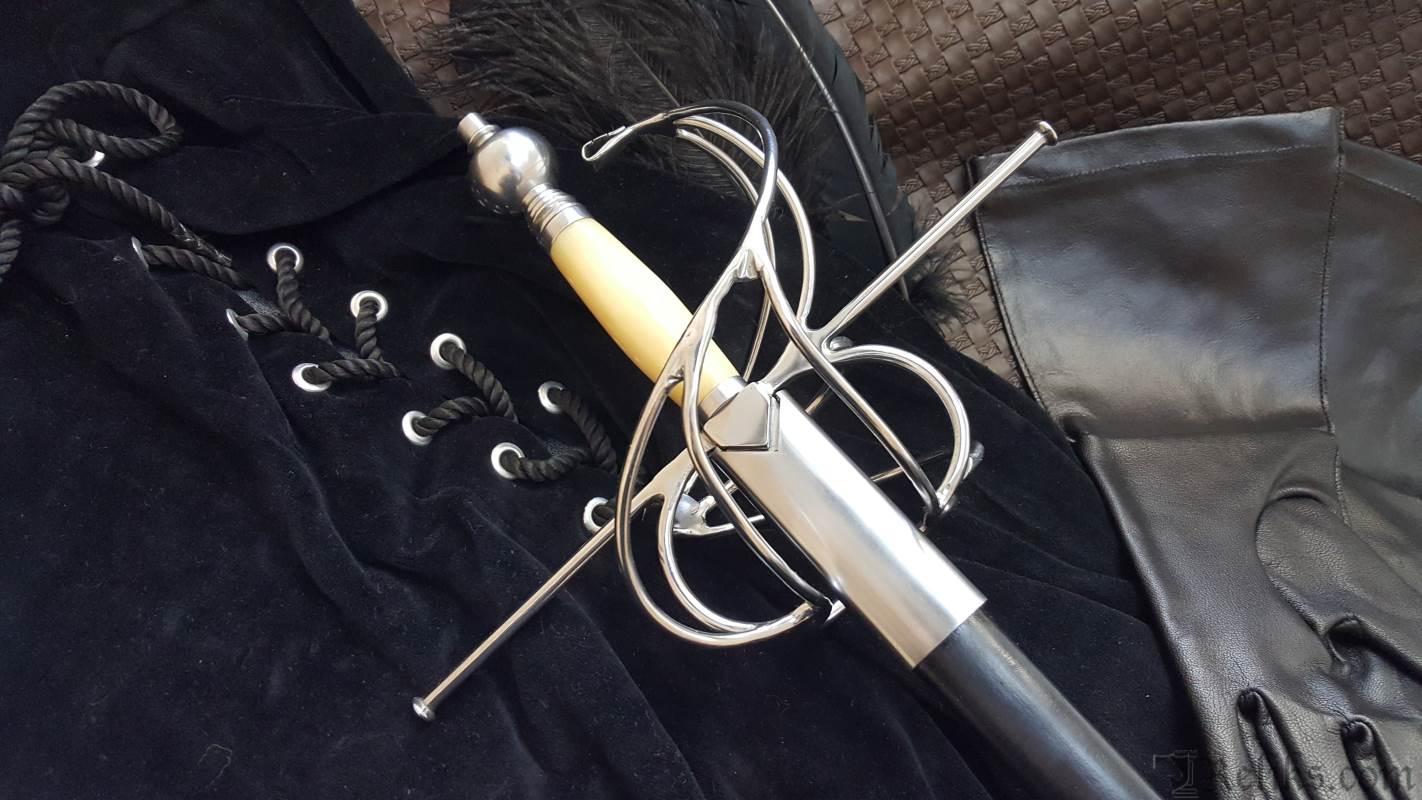
Pin em Blades
This rapier features a very complex Spanish-style hilt and faceted pommel. The grip is hand-wound with blackened wire with woven wire rings on top and bottom. The hand-forged, high carbon steel, fully tempered blade features a diamond cross-section to strengthen it for thrusting.

Meyer Training Rapier Arms & Armor
Its blade is typically long, narrow, and triangular or diamond-shaped in cross-section. The sharpness of a rapier is concentrated along the pointed tip and the leading edge, which is the edge that faces the opponent during a thrust.

Rapiers
This rapier from the early 17th century features a very stiff thrusting blade and a rather rare hilt form. The ricasso is of narrow, hollow-ground rectangular shape. The blade starts with almost rectangular cross-section with three fullers, at 10cm changing to hexagonal shape with one fuller ending in a diamond shaped debole.

Sections of a Swepthilt Rapier by Writing & History Reference Pinterest
The Rapier missile has a streamlined monocoque body of circular cross-section and consists of four main sections: warhead, guidance, propulsion unit and control. The 1.4 kg warhead section contains the semi-armour-piercing warhead, with 0.4 kg of explosive, a safety and arming unit and crush fuze.

Swept Hilt Rapier Functional Rapiers at
The rapier is the iconic sword of the renaissance, but it is often misunderstood due to poor representation in popular culture. The reality of the rapier is that it was a brutal and efficient killer. So much so that in Britain it was often considered a bullies or murderers weapon.

Rapier
The parrying dagger is a category of small handheld weapons from the European late Middle Ages and early Renaissance. These weapons were used as off-hand weapons in conjunction with a single-handed sword such as a rapier.

Katana, sabre, backsword, longsword, broadsword, rapier all share similar blade crosssections
The classic rapier - incredibly thin blade with an acute point, complex hilt, worn with civilian dress, fighting in a style that emphasized the point - had emerged by the mid 16th century, by which time people are alternately singing its praises and condemning it as the murderous and militarily useless tool of urban feuds.

Rapiers
It is typically triangular in cross-section, although some of the early examples still have the rhombic and spindle -shaped cross-sections inherited from older weapons, like the rapier. This triangular cross-section may be hollow ground for additional lightness.

Modern Rapier Blade triangular Cross Section Etsy
manufacturer. Light rapier blades 18" or shorter need only meet the requirements previously listed. v. Full length blades (i.e. greater than 18" in length from tip to top of the tang) with a cross-section similar to a foil or epee (i.e., foils, epees, double-wide epees and musketeers) are not allowed in Heavy Rapier, nor Cut & Thrust combat.

The anatomy of a fencing sword Academy of Fencing Masters Blog
They have a flattened triangular cross section and are light and very flexible. Their points are blunted but do not have the "button" used in competitive fencing.

Elector Saxon Military Rapier Malleus Martialis
The various historical terms for rapier referred to a slender cut-and-thrust sword capable of limited slashing and slicing blows and equally suited to military or civilian use. Eventually however, it came to mean exclusively a long and slender thrusting sword with virtually no edge.

Schiavona Rapier Rapier sword, Swords and daggers, Weapon concept art
The blade itself is diamond in cross-section with fluting. German or Swiss Rapier This sword dates from the late 16th Century. The overall length of the piece is 45 1/4". The blade is 39 1/2" long with a width of 1 1/4". The weight of the weapon is 3 lb. 2 oz. The pommel is diamond shaped and chiselled with lions' heads.

Rapiers Arms & Armor
There were a variety of cross section shapes, although a diamond-shaped cross section was most common (website: "Rapiers"). 20 .. A ringed cross guard (website: "Rapier Hilt"). Right: A Spanish-style cup guard (website: "Mini Spanish"). 9. Recreating the Rapier . The rapier replica was made with the help of Josh Swalec and.

Swept Hilt Rapier Functional Rapiers at
The small-sword as well as its method of use was developed by the French masters in the mid-1600s. As compared to its predecessor the rapier, the blade of this civilian sword was much shorter in length and lighter in weight. The earliest forms of this weapon were mounted with diamond cross-section rapier type blades. At the height of its.

Pin on Mid evil weapons, armor and castles
A rapier ( / ˈreɪpiər /) or espada ropera ( 'dress sword') is a type of sword used in Renaissance Spain [1] to designate a sword with a straight, slender and sharply pointed two-edged long blade wielded in one hand. [2] It was widely popular in Western Europe throughout the 16th and 17th centuries as a symbol of nobility or gentleman status.

Meyer Training Rapier Arms & Armor
The primary way to make a blade flexible is to increase the distal taper and make it thinner in cross section. Obviously you have to make it blunt and take the edge off too. However, a blunted rapier that maintains the rigidity of a real rapier will be far too dangerous to spar with outside of very controlled conditions.